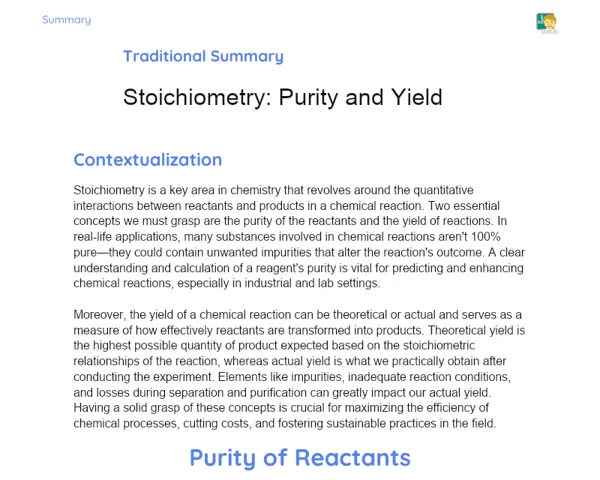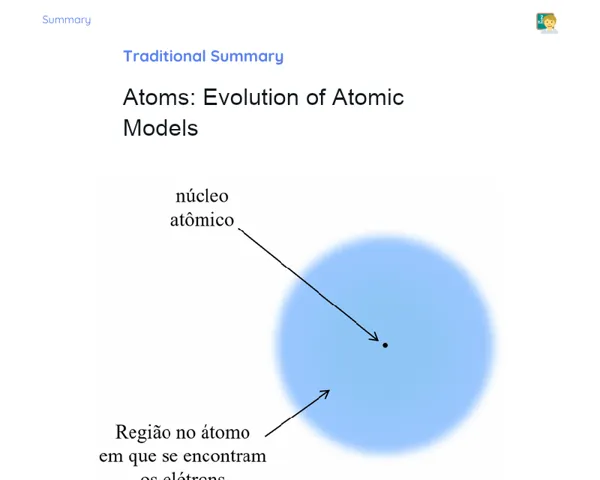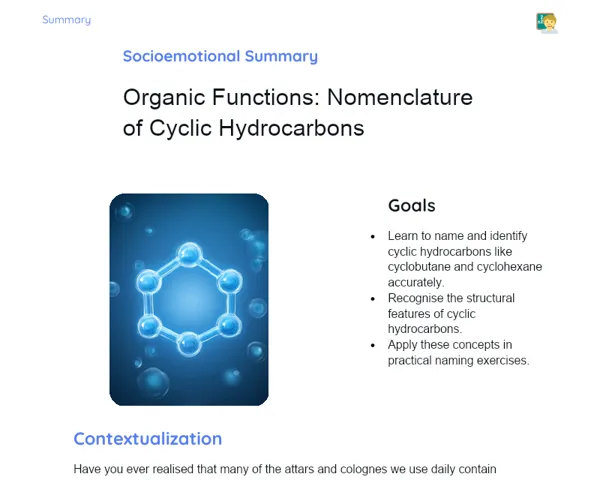Summary Tradisional | Molar Fraction Concentration Units
Contextualization
In the realm of Chemistry, solutions are pivotal across a range of applications, from laboratory experiments to industrial practices. Within this framework, concentration units are vital for accurately articulating the composition of these solutions. One such unit is the mole fraction, which signifies the ratio of a particular component to the total components present in a solution. Grasping the mole fraction is crucial for solution analysis, ensuring concentrations are sufficient for conducting experiments and producing quality industrial products.
The mole fraction finds significant use in the pharmaceutical sector, where it is essential to determine the right dosage of active ingredients in medications. Moreover, in water treatment techniques like reverse osmosis, the mole fraction of contaminants is a key metric for assessing the efficiency of purification processes. These instances underscore the practical significance of the mole fraction, extending beyond academic environments into real-world applications that affect health and environmental safety. Thus, mastering the calculation and use of the mole fraction is an indispensable skill for every Chemistry student.
To Remember!
Definition of Mole Fraction
The mole fraction is a concentration unit that represents the ratio of the number of moles of a specific component in a solution to the total number of moles of all components present in that solution. This unit is particularly beneficial for expressing the composition of solutions where the relative amounts of each component have more significance than the absolute quantities.
The mole fraction (X) is mathematically represented by the formula: X_i = n_i / n_total, where n_i is the number of moles of component i in the solution, and n_total is the total number of moles of all components in the solution. For instance, in a solution containing 2 moles of NaCl and 3 moles of H₂O, the mole fraction of NaCl would be 2/5 = 0.4, while the mole fraction of water would be 3/5 = 0.6.
Since the mole fraction is dimensionless, it makes for an adaptable tool when comparing the compositions of different solutions without worrying about unit conversions. Furthermore, the sum of all mole fractions in a solution amounts to 1, simplifying the verification of calculations and comprehension of relative proportions.
-
The mole fraction is the ratio of the number of moles of a component to the total number of moles in the solution.
-
The formula for mole fraction is X_i = n_i / n_total.
-
The sum of the mole fractions of all components in a solution equals 1.
Importance of Mole Fraction
The mole fraction is a fundamental concentration unit that is widely applied in various branches of Chemistry and its practical applications. It is regularly utilized to describe the makeup of solutions in chemical reaction studies, where the ratios of reagents can significantly affect the efficiency and outcome of the reaction.
In industrial settings, such as chemical and pharmaceutical production, the mole fraction is crucial for ensuring product quality and consistency. For example, in the pharmaceutical sector, it is vital to meticulously manage the mole fraction of active ingredients in medications for effectiveness and safety. Similarly, in water treatment processes, the mole fraction of contaminants is an essential factor for evaluating purification efficacy.
Moreover, the mole fraction is an important instrument in exploring chemical equilibrium and thermodynamics, as the proportions of components in a solution can influence the physical and chemical properties of the system. Accordingly, a solid understanding of the mole fraction is imperative for any chemist aiming to analyze and manipulate solutions effectively.
-
The mole fraction is vital for detailing the composition of solutions in chemical reactions.
-
It ensures product quality and consistency in the chemical and pharmaceutical industries.
-
It plays a significant role in studies of chemical equilibrium and thermodynamics.
Calculating Mole Fraction
Calculating the mole fraction necessitates several steps, commencing with determining the number of moles of each component in the solution. To achieve this, it is essential to know the mass of each component and its molar mass, which is the mass of one mole of molecules or atoms of that substance.
We start by converting the mass of the components to moles using the formula n = m/M, where n is the number of moles, m is the mass of the substance, and M is the molar mass. Once the number of moles of each component is established, we add them up to find the total moles in the solution.
Finally, the mole fraction for each component is obtained by dividing the number of moles of that component by the total number of moles in the solution. For example, if we have a solution containing 1.5 moles of glucose and 3.5 moles of water, the mole fraction of glucose would be 1.5/5 = 0.3 while that of water would be 3.5/5 = 0.7. This process guarantees that the sum of the mole fractions of all components equals 1, facilitating precise solution composition analysis.
-
Convert the mass of components to moles using the molar mass.
-
Add up the moles of all components to determine the total moles in the solution.
-
Divide each component's moles by the total moles to find its mole fraction.
Comparison with Other Concentration Units
The mole fraction is but one of the several concentration units employed in Chemistry. Other commonly used units include molarity (M) and molality (m), each with unique applications and benefits. Molarity denotes the number of moles of solute per litre of solution, whereas molality indicates the number of moles of solute per kilogram of solvent.
The primary distinction between the mole fraction and these other units is that the mole fraction is dimensionless, making it advantageous for comparing relative proportions without considering the volume or mass of the solvent. In contrast, molarity and molality come into play when it is necessary to relate the solute amount to the solvent's volume or mass, which is particularly relevant in titrations or studies of colligative properties.
Each concentration unit has its strengths based on the context of usage. The mole fraction excels in addressing relative composition and chemical equilibrium, while molarity is more convenient for aqueous solutions. Molality is preferred for studies involving temperature variations, as it remains unaffected by changes in volume stemming from temperature fluctuations.
-
The mole fraction is dimensionless and useful for comparing relative proportions.
-
Molarity relates to the moles of solute per litre of solution.
-
Molality relates to the moles of solute per kilogram of solvent.
Key Terms
-
Mole Fraction: The ratio of the number of moles of a component to the total number of moles in the solution.
-
Molarity: The number of moles of solute per litre of solution.
-
Molality: The number of moles of solute per kilogram of solvent.
-
Molar Mass: The mass of one mole of molecules or atoms of a substance.
-
Chemical Equilibrium: A state where the concentrations of reactants and products remain stable over time.
Important Conclusions
In this session, we delved into the concept of mole fraction, a vital concentration unit for detailing the composition of chemical solutions. We discussed the definition and calculation of mole fraction and recognised its importance in various practical scenarios, such as those encountered in the pharmaceutical industry and water treatment processes. We also compared the mole fraction to other concentration units like molarity and molality, pointing out the specific situations in which each unit proves more beneficial.
The mole fraction is an essential tool for any chemist, allowing for precise analysis of the relative proportions of components in a solution. This is critical for ensuring the effectiveness and safety of products in industrial processes, as well as for comprehending the physical and chemical properties of systems within chemical equilibrium studies. Hence, understanding mole fraction is an indispensable skill required for academic and professional achievement in Chemistry.
Students are encouraged to further explore this topic, as a thorough understanding of mole fraction and concentration units is crucial for solving complex problems and conducting accurate experiments. Ongoing practice and application of these concepts in various contexts will strengthen understanding and the ability to effectively work with chemical solutions.
Study Tips
-
Review the practical examples discussed in class and attempt similar problems to reinforce your understanding of mole fraction calculations.
-
Study other concentration units, like molarity and molality, and practice converting between them to solidify your knowledge of their appropriate usage.
-
Read articles and scientific literature that apply the concept of mole fraction in real-world contexts, such as the pharmaceutical industry or water treatment processes, to observe how theoretical knowledge is harnessed in practice.



